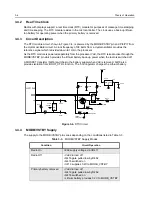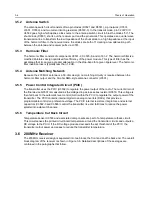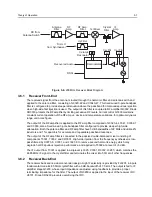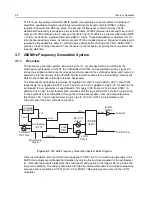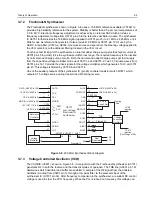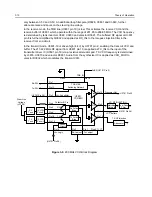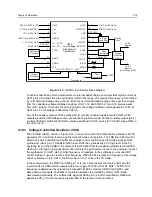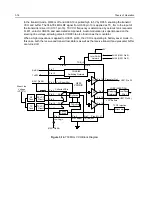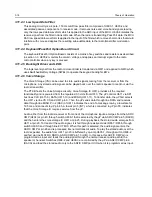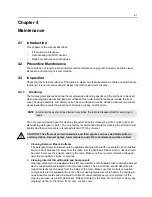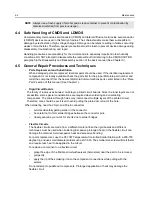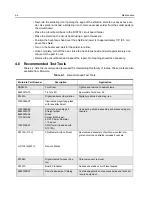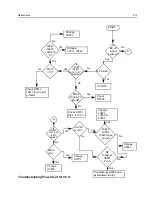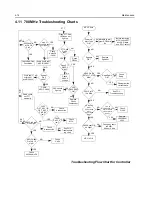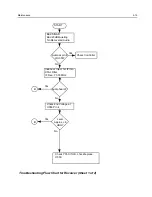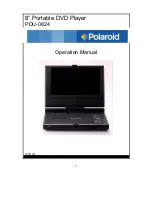
3-18
Theory of Operation
3.11.2.3 Low Speed Data Filter
This analog circuitry is a 4 pole, 150 Hz cutoff low pass filter comprised of U603-1, U603-2 and
associated passive components. In receive mode, it removes noise and voice band signals leaving
only the low speed data waveform which is applied to the ADC input of the MCU. U608-4 isolates the
receive signal from the filter in transmit mode. When the radio is transmitting PassPort data, the MCU
DAC low speed data waveform is applied to the input of the filter which removes harmonics that would
interfere with voice and applies the resulting sub-audible data to the radio transmitter modulation
point.
3.11.2.4 Keyboard/PassPort Option Board Circuit
The keyboard/PassPort Option Board consists of a matrix of key switches and resistors as described
in section 3.3. U605-2 monitors the column voltage and applies an interrupt signal to the radio
microcontroller when any key is pressed.
3.11.2.5 BackLight Driver and LED's
The logic level signal from the radio microcontroller is translated via Q611 and applied to Q610 which
uses Switched Battery Voltage (SWB+) to operate the keypad backlight LED’s.
3.11.2.6 Voice Storage
The Voice Storage (VS) can be used to store audio signals coming from the receiver or from the
microphone. Any stored audio signal can be played back over the radio’s speaker or sent out via the
radio’s transmitter.
The PTCB hosts the Voice Storage circuitry. Voice Storage IC U611 provides all the required
functionality and is powered from the regulated 3.3 volts from U610. The
µ
P controls U611 via SPI
bus lines CLK (U611-8), DATA (U611-10) and MISO (U611-11). To transfer data, the
µ
P first selects
the U611 via line VS CS and U611 pin 9. Then the
µ
P sends data through line DATA and receives
data through line MISO. Pin 2 (RAC) of U611 indicates the end of a message row by a low state for
12.5 ms and connects to
µ
P pin 65. A low at pin 5 (INT), which is connected to
µ
P pin 55, indicates
that the Voice Storage IC requires service from the
µ
P.
Audio, either from the radio’s receiver or from one of the microphone inputs, emerges from the ASFIC
CMP (U404) at pin 43, through switch U608-1 that is selected by the
µ
P via ASFIC CMP pin 5 (DACR)
and then enters the voice storage IC U611 at pin 25. During playback, the stored audio emerges from
U611 at pin 20. To transmit the audio signal, it is fed through resistive divider R657 / R658, through
switch U608-3 and through line EXT MIC. When this path is selected, the audio signal enters the
ASFIC CMP at pin 48 and is processed like normal transmit audio. To play the stored audio over the
radio’s speaker, the audio from U611 pin 20 is buffered by op-amp U605-1, through switch U608-2
and fed via line FLAT RX SND to ASFIC CMP pin 10 (UIO). In this case, this ASFIC CMP pin is
programmed as input and feeds the audio signal through the normal receiver audio path to the
speaker or handset. Switches U608-2 and U608-3 are controlled by the
µ
P via ASFIC CMP pin 6
(DACG) and feed the stored audio only to the ASFIC CMP port UIO when it is programmed as input.
Содержание HT1250-LS+
Страница 10: ...viii ...
Страница 12: ...x Product Safety and RF Exposure Compliance ...
Страница 16: ...1 4 Introduction ...
Страница 58: ...4 22 Maintenance ...
Страница 64: ...5 6 Schematic Diagrams Overlays and Parts Lists ...
Страница 102: ...5 44 Schematic Diagrams Overlays and Parts Lists Figure 5 34 Keypad PassPort Option Board Schematic Diagram ...

